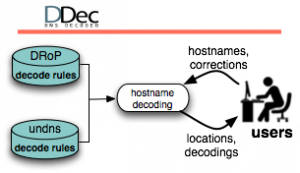Recent collections added to DatCat
Monday, September 29th, 2014 by Paul HickAs announced in the CAIDA blog “Further Improvements to the Internet Data Measurement Catalog (DatCat)” of August 26, 2014, the new Internet Data Measurement Catalogue DatCat is now operational. New entries by the community are welcome, and about a dozen have been added so far. We plan to advertise new and interesting entries on a regular basis with a short entry in this blog. This is the first contribution in this series.
Added on July 31, 2014, was the collection “DNS Zone Files”.
http://imdc.datcat.org/collection/1-0718-Y=DNS-Zone-Files;
contributed 2014-07-31 by Tristan Halvorson:
This collection contains Zone files with NS and A records for all new (2013 and later) TLDs.
ICANN has opened up the TLD creation process to a large number of new registries with a centralized service for downloading all of this new data. Each TLD has a separate zone file, and each zone file contains entries for every registered domain. This data collection contains step-by-step instructions to acquire this data directly from the registries through ICANN. This method only works for TLDs released during 2013 or later.

